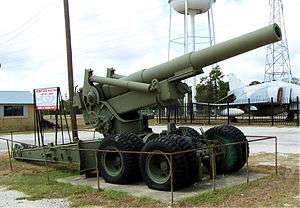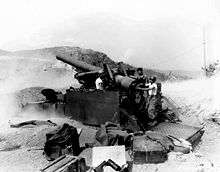M115 howitzer
| M115 203 mm howitzer | |
|---|---|
 A M-115 203 mm howitzer on display at Bastrop, Texas, United States. | |
| Type | Howitzer |
| Place of origin | United States |
| Production history | |
| Designed | 1939 |
| Specifications | |
| Weight | 14,515 kg (31,780 lbs) |
| Length | Travel: 10.972 m (36 ft 0 in) |
| Barrel length | 5.1 m (16 ft 9 in)[1] |
| Width | Travel: 2.5 m (8 ft 2 in)[1] |
| Height | Travel: 2.7 m (8 ft 10 in)[1] |
| Crew | 14 |
|
| |
| Shell | Separate loading charge and projectile 90.7 kg (200 lb)[1] |
| Caliber | 203 mm (8 in) |
| Breech | Interrupted screw |
| Recoil | Hydro-pneumatic |
| Carriage | Split trail |
| Elevation | −2° to +65° |
| Traverse | +60° |
| Rate of fire |
1 rpm (maximum) 3 rounds per 2 minutes (maximum) |
| Muzzle velocity | 587 m/s (1,926 ft/s) |
| Effective firing range | 16,800 m (18,373 yds) |
The M115 203 mm howitzer, also known as the M115 8 inch howitzer, was a towed howitzer developed and used by the United States Army.
History
Until the 1950s it was designated the 8 inch Howitzer M1. The original design started in 1919 but lapsed until resurrected in 1927 as a partner-piece for a new 155 mm gun. It was standardized as 8 inch Howitzer M1 in 1940. The M115/M1 was towed by the M35 Prime Mover gun tractor or a Mack 7⅓ ton 6×6 truck. The M115 was towed with 21 men per gun, and was shipped over to Germany Oct 1961 in response to the Berlin Crisis.
Like the British BL 8 inch Howitzer of the First World War (and most other large artillery), the M115 uses a Welin screw for its breech. The carriage was the same as used for the US 155 mm gun and was also adopted by the British for their 7.2 inch howitzer. It consists of equilibrator assemblies, elevating and traversing mechanisms, two single-wheel, single-axle heavy limber, and a two-axle bogie with eight tires and two trails. Four spades, carried on the trails, are used to emplace the weapon. The British 8 inch howitzer was produced in England and under license in the US, for the American Expeditionary Forces in Europe during World War I, as the 8-inch Howitzer MK. VI.[2] It was in service with the US Army till replaced by the M115. There are no reports of the MK. VI or another marks being used during World War II.
The first photos of the M115 type 8 inch cannon on its redesign carriage appeared in 1931 but development was slowed by the Great Depression.[3]
The M115 saw U.S. service in World War II, the Korean War, and the Vietnam War. In the late 1950s, it was adopted in small numbers by several NATO armies, to fire the W33 (M422/M422A1 shell) and later the W79 nuclear artillery shell, under the NATO nuclear sharing concept, a role which ended when the smallest types of tactical nuclear weapons were removed from service and eliminated. It was also adopted as a field weapon by a number of nations in Europe, the Middle East, and Asia and saw service in the Second Taiwan Strait Crisis and the Croatian War of Independence.
Operators

.svg.png)












Self-propelling mounts

- The howitzer was mounted on a modified M4 medium tank chassis, in mount M17. The resulting vehicle was initially designated 8 inch Howitzer Motor Carriage T89 and eventually standardized as the 8 inch Howitzer Motor Carriage M43. A total of 48 units were built.[5]
- 8 inch Howitzer Motor Carriage T80 – based on T23 Medium Tank chassis, never advanced past proposal stage.[6]
- 8 inch Howitzer Motor Carriage T84 – based on T26 Medium Tank chassis, a single pilot was built in 1945.[7]
- The howitzer was mounted on a purpose-built tracked chassis to become the 8 inch Self-Propelled Howitzer M110. Notably accuracy and rate of fire suffered from having to depress the cannon tube to loading elevation for each round in order to use the track-mounted auto loader.
Ammunition
The howitzer fired separate loading, bagged charge ammunition, with seven different propelling charges, from 1 (the smallest) to 7 (the largest).
| Projectiles.[8][9] | |||||
| Type | Model | Weight | Filler | Muzzle velocity | Range |
| HE | HE M106 Shell (charge M2) | 90.7 kg (200 lb) | 594 m/s (1,950 ft/s) | 16,926 m (11 mi) | |
| HE | HE Mk 1A1 Shell (charge M1) | 90.7 kg (200 lb) | 408 m/s (1,340 ft/s) | 10,214 m (6.3 mi) | |
| Dummy | Dummy Mk 1 Projectile | — | — | — | |
| Nuclear | M442 (W33) nuclear shell | — | — | 18,000 m (11 mi) | |
| Propelling charges.[10] | ||
| Model | Weight, complete | Components |
| M1 ("green bag") | 6.3 kg (13 lb 14 oz) | Five incremental charges (for charges 1 to 5) |
| M2 ("white bag") | 13.56 kg (29 lb 14 oz) | Base charge and two incremental charges (for charges 5 to 7) |
| M4 (dummy) | 13.04 kg (28 lb 12 oz) | Base charge and two incremental charges |
| Concrete penetration[11] | ||||
| Ammunition / Distance | 2,743 mm (9 ft) | 4,572 mm (20 ft) | 9,144 mm (30 ft) | 13,716 mm (50 ft) |
| HE M106 Shell (meet angle 0°) | 1,432 mm (4 ft 8 in) | 1,219 mm (4 ft) | 975 mm (3 ft 2 in) | 945 mm (3 ft 1 in) |
| Different methods of measurement were used in different countries / periods. Therefore, direct comparison is often impossible. | ||||
See also
- 203 mm howitzer M1931 (B-4)—approximate Soviet equivalent
- BL 7.2-inch howitzer—British equivalent
- List of U.S. Army weapons by supply catalog designation—SNL D-29
Notes
- 1 2 3 4 Foss, Christopher (1977). Jane's pocket book of towed artillery. New York: Collier. p. 141. ISBN 0020806000. OCLC 911907988.
- ↑ US Army manual TM 9-2005, December 1942 Page 79
- ↑ "First Mile A Minute Army", October 1931, Popular Science photo bottom of page 53
- ↑ John Pike. "Pakistan Army Equipment". Globalsecurity.org. Retrieved 2013-03-19.
- ↑ Hunnicutt - Sherman: A History of the American Medium Tank, pp. 353–355, 571.
- ↑ Hunnicutt - Pershing, A History of the Medium Tank T20 Series, p. 158.
- ↑ Hunnicutt - Pershing, A History of the Medium Tank T20 Series, p. 159.
- ↑ Technical Manual TM 9-1901, Artillery Ammunition, pp. 203–205.
- ↑ "W33". Global Security. Retrieved 25 July 2018.
- ↑ Technical Manual TM 9-1901, Artillery Ammunition, p 301, 311.
- ↑ Hunnicutt - Sherman: A History of the American Medium Tank, p 571.
References
- Hunnicutt, R. P. (1994). Sherman: A History of the American Medium Tank. Presidio Press. ISBN 0-89141-080-5.
- Hunnicutt, R. P. (1996). Pershing: A History of the Medium Tank T20 Series. Feist Publications. ISBN 1-112-95450-3.
- Technical Manual TM 9-1901: Artillery Ammunition. War Department. 1944.
- "M115 8 in (203 mm) howitzer". FAS Military Analysis Network. Retrieved May 31, 2005.
- Missing Lynx
- TM 9-2300 Standard Artillery and fire Control Material (dated Feb. 1944)
- TM 9-335
- TM 9-1350
External links
